
Forty Years ago in the X-15 Flight Test Program, July - August 1961 |

The NB-52B, 52-0008 had not launched an X-15 since March 30, 1961. It was engaged in a series of "functional" flights and tests with a pod that simulated the systems of the X-15. The pod was a modified fuel tank left over from the North American F-107 program. It was also equipped with accelerometers to determine the loads imposed on the X-15 while it was hanging from the pylon on the wing of the Stratofortress. The NB-52B flew seven pod flights between March and December.
The XLR-99 engine had been installed in the X-15-1 following its last flight with the XLR-11 engines on February 7. Commander Forrest Petersen was scheduled to make the first flight of the X-15-1 with the XLR-99 engine on July 14. It would be his third X-15 flight and the twenty-second flight of the X-15-1.
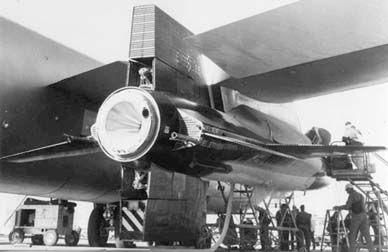 The X-15-1 with its XLR-99 engine
hangs from the pylon of the NB-52A. Photo E88-013-02 courtesy
NASA Dryden.
The X-15-1 with its XLR-99 engine
hangs from the pylon of the NB-52A. Photo E88-013-02 courtesy
NASA Dryden.
Contamination of the anhydrous ammonia fuel resulted in the postponement of the first attempt to launch the X-15 with the XLR-99 engine. The launch was rescheduled for August 1, but it was canceled. Bad weather forced a postponement of the next launch attempt on August 2. Bad weather and a faulty propellant tank regulator aborted the launch attempt on August 3, and continued bad weather prevented a launch on August 4.
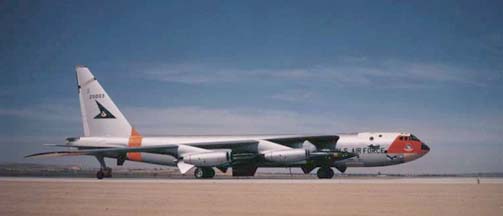 NB-52A with X-15-1 on runway 04
before mission 1-22-37. This photo illustrates the changes to the
appearance of the NB-52A that were made when it was at Boeing in
Wichita, Kansas for maintenance earlier in the year. The exposed
bare metal of the Stratofortress has been painted silver. The
white area above the crew compartment has been extended forward
over the pilots. The mothership wears the name "The High and
Mighty One" and nose art depicting an eagle dropping an X-15
from its talons. The outline of the high-visibility Day-Glo red
around the cockpit has changed. The Day-Glo red on the nose does
not match the Day-Glo orange of the rear fuselage band. The rear
fuselage band has been moved farther to the rear and extends onto
the vertical stabilizer. The black chevron on the tail is much
broader than it had been. Black anti-glare paint has been added
around the rear gunner's station. The engine nacelles are painted
silver, but will later be painted light gray. The white chin and
belly radomes have been replaced with buff colored radomes. It
can't be seen in this picture, but the flaps on both wings are
now painted white. Photo EC6299 courtesy NASA Dryden.
NB-52A with X-15-1 on runway 04
before mission 1-22-37. This photo illustrates the changes to the
appearance of the NB-52A that were made when it was at Boeing in
Wichita, Kansas for maintenance earlier in the year. The exposed
bare metal of the Stratofortress has been painted silver. The
white area above the crew compartment has been extended forward
over the pilots. The mothership wears the name "The High and
Mighty One" and nose art depicting an eagle dropping an X-15
from its talons. The outline of the high-visibility Day-Glo red
around the cockpit has changed. The Day-Glo red on the nose does
not match the Day-Glo orange of the rear fuselage band. The rear
fuselage band has been moved farther to the rear and extends onto
the vertical stabilizer. The black chevron on the tail is much
broader than it had been. Black anti-glare paint has been added
around the rear gunner's station. The engine nacelles are painted
silver, but will later be painted light gray. The white chin and
belly radomes have been replaced with buff colored radomes. It
can't be seen in this picture, but the flaps on both wings are
now painted white. Photo EC6299 courtesy NASA Dryden.
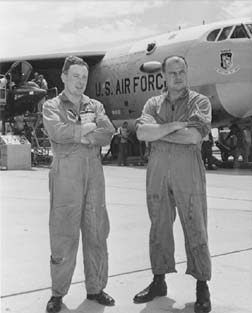 Captain Jack Allavie and RAF
Squadron Leader Harry Archer finally launched Commander Petersen
from the NB-52A, 52-0003 on August 10. Photo courtesy Air Force
Flight Test Center History Office.
Captain Jack Allavie and RAF
Squadron Leader Harry Archer finally launched Commander Petersen
from the NB-52A, 52-0003 on August 10. Photo courtesy Air Force
Flight Test Center History Office.
The flight plan called for Petersen to keep the XLR-99 engine at 50% throttle to reach a maximum velocity of Mach 3.7, the slowest velocity for an X-15 flight since the last XLR-11 flight in February.
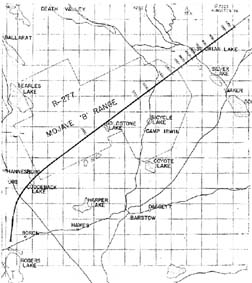 Because of the relatively low speed of the flight, the X-15-1 was
launched over Silver Lake, just north of the town of Baker,
California. Petersen actually reached Mach 4.11 on this flight.
Because of the relatively low speed of the flight, the X-15-1 was
launched over Silver Lake, just north of the town of Baker,
California. Petersen actually reached Mach 4.11 on this flight.
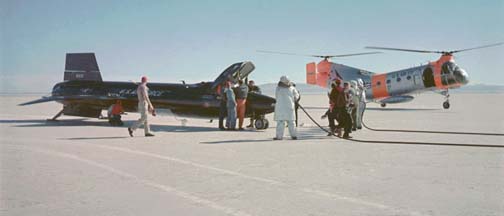 Ground crew tends to X-15-1 on Rogers Dry Lake.
Rescue helicopter HH-21B, 53-4389 sits on the lakebed in the
background. Photo courtesy AFFTC/HO.
Ground crew tends to X-15-1 on Rogers Dry Lake.
Rescue helicopter HH-21B, 53-4389 sits on the lakebed in the
background. Photo courtesy AFFTC/HO.
 Books about
the X-15 available from
Books about
the X-15 available from 
 X-15 (The Nasa Mission Reports)
X-15 (The Nasa Mission Reports)
 Angle of Attack : Harrison Storms and the Race to
the Moon by Mike Gray. The biography of Harrison Storms, who
was instrumental in the development and operation of the X-15.
Angle of Attack : Harrison Storms and the Race to
the Moon by Mike Gray. The biography of Harrison Storms, who
was instrumental in the development and operation of the X-15.
 At the Edge of Space : The X-15 Flight Program
by Milton O. Thompson. The story of test flying the X-15 from the
point of view of the pilot.
At the Edge of Space : The X-15 Flight Program
by Milton O. Thompson. The story of test flying the X-15 from the
point of view of the pilot.
*The first position of the mission number identifies which X-15 was involved, the second number indicates how many times that X-15 had been launched, and the third number indicates how many times it had been carried by an NB-52.
Send a message to Brian
Go to home page of the Goleta Air & Space Museum.